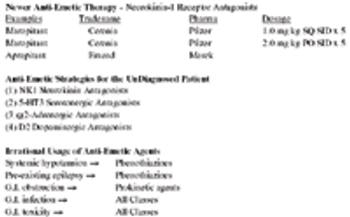
Las Vegas - New data suggests that nearly half of the states in this country reported 500-plus Lyme positive dogs between 2001 and July 2009.

Las Vegas - New data suggests that nearly half of the states in this country reported 500-plus Lyme positive dogs between 2001 and July 2009.

A Q&A with veterinary nutritional expert Dr. Rebecca Remillard

Bragg Creek, Alberta - A pilot study using deslorelin contraceptive implants in 15 semi-feral dogs is showing promise as a way to control feral dog populations.

A proper understanding of the terms acidosis, alkalosis, acidemia, and alkalemia is necessary to differentiate simple from mixed acid base disorders. Acidosis and alkalosis refer to the pathophysiologic processes that cause net accumulation of acid or alkali in the body, whereas acidemia and alkalemia refer specifically to the pH of extracellular fluid.

Non-core vaccines are those which we as a profession have determined are not recommended for all dogs or cats. Vaccination, in general, has the benefit of potentially lessening the prevalence or severity of disease, ensuring that patients are examined on a regular basis, increasing practice revenue, and potentially saving clients money in the long-run.

Simplistically speaking, antibiotic-responsive diarrhea is a case of diarrhea that responds to antibiotic therapy.

The initiating event of acute pancreatitis is the premature activation of digestive zymogens within the acinar cell. Premature activation of digestive zymogen results in acinar cell necrosis and pancreatic autodigestion.

The typical clinical signs of anemia are weakness, exercise intolerance, inappetance or anorexia, pale mucous membranes, tachypnea, and icterus. The degree to which these clinical signs are manifested are dependent on the speed at which the anemia develops and the severity of the anemia.

Whenever possible the inciting cause should be removed. However, as indicated above this may be difficult to accomplish as most cases of canine and feline pancreatitis are idiopathic.

Zoonotic disease has always been an area where veterinarians have been involved. Zoonotic infections can be viral, bacterial, fungal and parasitic in origin.

Mechanisms of gastrointestinal smooth muscle contraction have been a longstanding area of research interest. Our laboratory has been particularly interested in the role of myosin light chain phosphorylation in the regulation of contraction.

Small intestinal disease can be acute or chronic. Acute small intestinal disease is most commonly dietary due to ingestion of food that leads to adverse reactions, infectious due to Parvovirus enteritis or other enteric pathogens, or mechanical due to foreign bodies, intussusceptions, or torsions.

For most diagnostic tests, the 'titer' is the minimum dilution of a substance that is required to yield a positive result.

In human medicine, fever of unknown origin (FUO) is defined as pyrexia of greater than two to three weeks duration (i.e. sufficient time for self-limiting infections to resolve) during which repeat physical examinations and standard diagnostic testing have failed to reveal an underlying cause.

It is known that high blood pressure is associated with renal disease in many species including cats and dogs. That this is important is known from many studies including ones involving dogs.

Constipation is a frequent complaint middle aged to older cats. In some cases the disease becomes refractory enough to treatment that either subtotal colectomy or euthanasia have to be considered.

Hyperadrenocorticism remains one of the most common endocrine disorders diagnosed in the geriatric dog population. It is a disease that is seen in almost every veterinary practice.

Endocardiosis is the most common cause of heart failure in small breed dogs and the most common cause of heart failure in dogs in general.

Vomiting is among the most common clinical signs in companion animals. Although a protective mechanism associated with removal of noxious ingested substances, it is also associated with many diseases. Due to the multitude of causes it can be a challenge for veterinarians to diagnose and manage vomiting.

Cobalamin (vitamin B12) is a cyclic tetrapyrrol that contains a corrin ring with a cobalt atom in the center. Cobalamin is actually made up of a group of compounds and is exclusively derived from bacterial sources.

Diarrhea is one of the most common clinical signs seen in dogs. There are many different approaches for the work-up of chronic diarrhea.

Nontraumatic inflammatory joint disease is a relatively common, but under-recognized, cause of fever and morbidity in dogs. In one review of 66 dogs referred for fever of unknown origin to a veterinary teaching hospital, approximately 8% were diagnosed with immune-mediated polyarthritis.

A complete and detailed history is the first step in establishing a correct diagnosis of a vomiting disorder. The patient's signalment will usually establish some level of probability for many of the differential diagnoses.

There are many potential causes of acute diarrhea in cats, but a smaller number of etiologies are associated with the development of feline chronic diarrhea.

he incidence of exocrine pancreatic disorders is quite large in both dogs and cats. In a large retrospective study of necropsy findings 1.5% of 9,342 canine and 1.3% of 6,504 feline pancreata showed significant pathological lesions.

Dogs with immune-mediated thrombocytopenia (ITP) usually present with platelet counts low enough to be considered life-threatening, although overt signs of bleeding are uncommon.

Over 90% of the potassium in the body is located within cells. External balance for potassium is maintained by matching output to input.

This session will deal with case examples where blood pressure measurement is indicated. This is meant to be an interactive session with participation of the attendees. Your diagnostic skills will be tested as will your knowledge on blood pressure issues.

The volume and tonicity of body fluids are maintained within a narrow normal range by regulation of sodium and water balance. The volume of extracellular fluid (ECF) is determined by the total body sodium content, whereas the osmolality and sodium concentration of ECF are determined by water balance.

Immune-mediated hemolytic anemia is one of the most common reasons for referral to veterinary internists. The most common presenting complaint is that the patient is inadequately responding to appropriate immunosuppression.